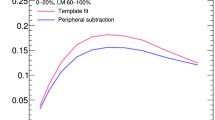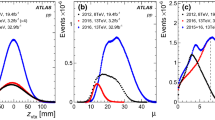Abstract
Azimuthal anisotropy in high-multiplicity small system collisions is often quantified by the harmonic modulations cn = ‹cos (nΔφ)› in di-hadron azimuthal correlations, with a non-flow baseline subtraction using correlation functions in low-multiplicity events. We present mathematical evaluations for three different baseline subtraction methods; i) the template fit method, ii) the reference fit method, and iii) the c1 scaling method. We describe conceptual differences among the three methods. These methods are compared and examined using a toy Monte Carlo model with various realistic cn values implemented in high-multiplicity events. Our results show the reference fit method is more stable than the template fit method because the reference fit does not estimate the flow yield. On the other hand, the template fit method can evaluate the flow effect reasonably, for the case where the flow does not contain c1 factor.
Similar content being viewed by others
References
A. Adare et al., Phys. Rev. Lett. 107, 252301 (2011).
A. Adare et al., Phys. Rev. C 94, 054910 (2016).
A. Adare et al., Phys. Rev. Lett. 98, 162301 (2007).
L. Adamczyk et al., arXiv:1712.01332.
N. M. Abdelwahab et al., Phys. Lett. B 745, 40 (2015).
B. I. Abelev et al., Phys. Rev. C 81, 44902 (2010).
Y. Pandit, J. Phys. Conf. Ser. 458, 012003 (2013).
G. Aad et al., Phys. Rev. C 86, 014907 (2012).
J. Velkovska, J. Phys. G 38, 124011 (2011).
A. M. Sirunyan et al., arXiv:1711.05594.
J. Adam et al., Phys. Rev. Lett. 116, 132302 (2016).
K. Adcox et al., Nucl. Phys. A 757, 184 (2005).
G. Aad et al., Phys. Rev. Lett. 116, 172301 (2016).
V. Khachatryan et al., Phys. Lett. B 765, 193 (2017).
G. Aad et al., Phys. Rev. Lett. 110, 182302 (2013).
S. Chatrchyan et al., Phys. Lett. B 718, 795 (2013).
C. Aidala et al., Phys. Rev. C 95, 034910 (2017).
C. Aidala et al., Phys. Rev. C 96, 064905 (2017).
A. Adare et al., Phys. Rev. Lett. 115, 142301 (2015).
L. Adamczyk et al., Phys. Rev. C 94, 34908 (2016).
S. Esumi, PoS CPOD2017 018 (2018).
Author information
Authors and Affiliations
Corresponding author
Rights and permissions
About this article
Cite this article
Han, S., Esumi, S., Sato, K. et al. A New Baseline Subtraction Method for Di-hadron Correlations in High-multiplicity Small System Collisions. J. Korean Phys. Soc. 73, 677–683 (2018). https://doi.org/10.3938/jkps.73.677
Received:
Accepted:
Published:
Issue Date:
DOI: https://doi.org/10.3938/jkps.73.677




